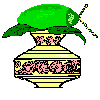

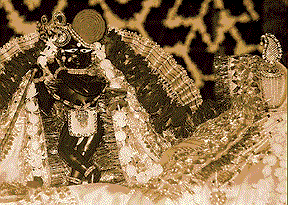



Newsletter
#007
Gaura Purnima issue 2005



For Silas and Their sevaks
http://www.salagram.net/Sri-Shaligram-Tirtha.htm
mirrored @
http://www.hknet.org.nz/Sri-Shaligram-Tirtha.htm
http://www.silas.alturl.com
or
http://silas.areCool.net
The Nectar
in this Issue
 IN
THIS ISSUE: (click on the hyper-linked underlined
below to jump there...)
IN
THIS ISSUE: (click on the hyper-linked underlined
below to jump there...)

 Intro'
Intro'
 Feature
Article - Advaita Acharya
invoked Gauranga Mahaprabhu to appear worshipping the Salagram........
Feature
Article - Advaita Acharya
invoked Gauranga Mahaprabhu to appear worshipping the Salagram........
 Festivals
Coming - Gaura Purnima - The Divine Appearance
Day of Sri Krishna Chaitanya Mahaprabhu
Festivals
Coming - Gaura Purnima - The Divine Appearance
Day of Sri Krishna Chaitanya Mahaprabhu
 Modes
of Worship:
Modes
of Worship:
 About
the web-site: What's there - how to utilize it.......
About
the web-site: What's there - how to utilize it.......
 New
Entries on the Web-site..... quite a few since the last newsletter.
New
Entries on the Web-site..... quite a few since the last newsletter.
 SEARCH
for Ishthadevatas and Devotees on the site......
SEARCH
for Ishthadevatas and Devotees on the site......
 Please
Visit the ARTICLES pages
Please
Visit the ARTICLES pages
 Vaishnava
Calendar - Panjika
Vaishnava
Calendar - Panjika
 The
Salagram Sila - some nice information from Shastra:
The
Salagram Sila - some nice information from Shastra:
 Shree Vishotara
Purane Shree Saligram Sila-stotram
Shree Vishotara
Purane Shree Saligram Sila-stotram
 Words
of encouragement from HDG
Words
of encouragement from HDG
 Sila
katha - Swadhyaya - glorifying the Lord and His devotees
Sila
katha - Swadhyaya - glorifying the Lord and His devotees
 Shaligram
mahima - part 1
Shaligram
mahima - part 1
 Hari Bhakti
Vilas on Salagram Silas and Their importance
Hari Bhakti
Vilas on Salagram Silas and Their importance
 Salagram
Kosha - chapter Five - by SK Ramachandra Rao
Salagram
Kosha - chapter Five - by SK Ramachandra Rao
 Correspondence
Correspondence
 - Funny story ...from
Ekendra prabhu to JTCd
- Funny story ...from
Ekendra prabhu to JTCd
 - Some great
places to purchase your puja paraphernalia on-line
- Some great
places to purchase your puja paraphernalia on-line
 Advertisements
for Salagram friendly sites
Advertisements
for Salagram friendly sites
 Pilgrimage
to the top of the world - Damodar Kunda
Pilgrimage
to the top of the world - Damodar Kunda
 Newsletters
On-line
Newsletters
On-line
 Happy 2005 (519 Gaurabda)
Happy 2005 (519 Gaurabda)
 Outro'&
Thanx
Outro'&
Thanx


Sri-murti-lakshana,
aara shaalagraama-lakshana
krishna-kshetra-yaatraa, krishna-murti-darshana
“The characteristics of the Deities
should be discussed, as well as the characteristics of the Shalagrama-shila.
You should also discuss visiting the Deities in the temple and touring
holy places like Vrindavana, Mathura and Dvaraka."
(Sri Chaitanya Charitamrita
Madhya-lila 24:335. text - 61 Explanations of Atmarama verse)

"In the material world also, wherever the Supreme Lord
is personally present is to be understood as being the spiritual world.
For example, the Lord is worshipped in the temple by pure devotees. The
Temple is therefore to be understood as being the spiritual world." (Srimad
Bhagavatam 4.11.26 Purport)

"The Lord in the temple in the worshipable form is never
to be considered to be made of stone or wood, for the Lord in His arca
incarnation as the Deity in the temple shows immense favor to the fallen
souls by His auspicious presence. By the hearing process, as mentioned
hereinbefore, this realization of the presence of the Lord in the temple
is made possible."
(Srimad-Bhagavatam, 2.3.21, Purport)


 ...Intro'
...Intro'
Hare Krishna
Namaskaragalu - Vanakkam - G'day
Please accept my respectful obeisances,
All glories to Srila Prabhupad, All glories to Sri Guru and Gauranga,All
glories to all the Vaishnava devotees of the Lord
Chari Vaishnava sampradaya ki jaya
Sri Swayam-vyakta Shaligram Sila, Dwaraka
Sila, Govardhan Sila ki jaya
Welcome to what we hope to be the sixth
of many newsletters. The present plan is to attempt to maintain the site
nicely and keep updating with new information and pictures and additions
to help enthuse everyone, and use this newsletter to help keep everyone
informed about that. With my other various services we figured that Quarterly
would be a feasible beginning, so we are looking at April - July - Sept
- Dec for now.
So we went a bit off from that with
unforeseeable situations occuring, my having to be away from my system
for a few months and losing my old faithful computer's contents to hacker's
attacks. Yes, it has been a rather eventful year with many things happening.
We have experienced many new things, learned many new things, welcomed
many new friends - as some wise sage once said "There are no strangers,
only friends we have yet to meet !" So that has become manifest as many
devotees unknown to me previously wrote in and sent pictures of their worshiful
Lords. We too by the mercy of the Lord and His devotees have received a
few new additions to try to render some seva to.
As Krishna consciousness is ever expanding
and ever deepening we would like to expand this service to you all so as
to receive your blessings. Therefore we very much welcome constructive
feedback to further assist the development of the site and newsletter services
- always open to that.
Sri Krishnarpanamastu
yhs, JTCd


Festivals
Coming Soon
Gaura Purnima Celebrations
Gaura Purnima 26th March in New Zealand (25th in some
places East of us)
Moonrise is at 5:05pm (17:05 hrs) including Daylight
Savings Time in NZ
http://aa.usno.navy.mil/data/docs/RS_OneDay.html
(check your place's exact Moon rise time here)
Sri Gaura Purnima (Fasting 'til Moonrise - 26th March
2005)
( Ekadasi style breakfasting -
non-grain )
For more information about the appearance Day
of Sri Krishna Chaitanya Mahaprabhu 518 Gaurabda
Next Day - Festival of Jagannath Misra -
Jata Karman Samskara for baby Lord Chaitanya and feasting
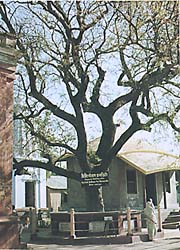
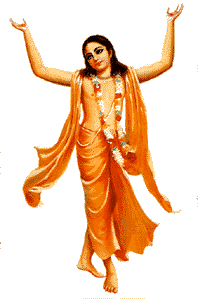
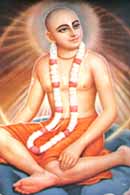

Sri Gaura Purnima - Advent of
Sri Krishna Chaitanya Mahaprabhu
26th March in NZ

 ...Feature
Article:
...Feature
Article: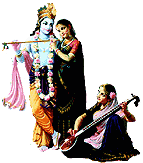

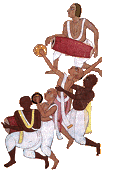
(To view some of the texts on this
newsletter you will need to have the Balaram font installed on your system.
You can download it for free HERE and then go to
Start, settings, control panel and Fonts and Install New Fonts)
Advaita Acharya invokes Lord Chaitanya to appear through
worshipping the Salagram sila:
http://www.salagram.net/parishad31.htm
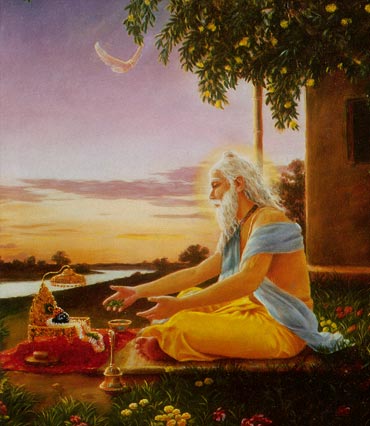
The foremost of all the Vaishnavas who reside at Navadwip is Sri Advaita
Acarya, whose virtuous presence has made all the worlds blessed. He is
the most preeminent preceptor in all fields including knowledge, renunciation
and devotion. In explaining Krsna-bhakti he is like unto Lord Shankara
(Shiva) himself, and whatever scriptures that exist within the three worlds
he explains in the light of Krsna-bhakti.
With the intense eagerness he continually worships the Shalagram of
Sri Krsna with Tulasi manjaris and Ganges water. By the momentum of his
spiritual force, his loud shouts pierce the coverings of this universe
and, resounding throughout Vaikuntha, reach the ears of Sri Krsna. Hearing
this loving summons saturated with devotion, Sri Krsna advents Himself.
On the seventh day of the bright fortnight of the month of Magh, the
great ocean of ecstasy swelled to its limits, being forcibly attracted
by the moon of Adwaita, Who appeared from the womb of Sri Nabhadevi as
the moon appears in the autumn sky. His father, Sri Kuvera, Pandit floated
in that ocean of joy. In great happiness gave many gifts in charity to
the brahmanas (who voluntarily accept vows of poverty). Very quietly he
approached the maternity room to get a glimpse of his newborn son. Then
his own face began to shine by the reflected light of that moon-like personage.
The residents of Nabagram came running to see the child. Everyone remarked
that they had never seen such a beautiful baby. What a pious activities
his father must have been performed to get such a jewel of a son, and that
in his old age. Thus Ghanasyama sings about this occasion. [B.R.12.1759]
The child was named Mangal and his other name was Kamalaksa.
Advaita Acarya is the combined incarnation of Maha Visnu and Sadaisiva
(who resides in Goloka). His two consorts, Sita and Sri are manifestations
of Yoga Maya. Once when Advaita performed worship, whatever gods and demigods
He used to meditate upon He saw all gathered at Lord Caitanya's lotus feet,
offering prayers. Raising up his two hands, Advaita exclaimed in great
ecstasy, "Today all the days of my life have produced a successful result,
as all my desires have been fulfilled. My birth and activities have finally
born fruit. I have directly perceived Your two lotus feet, which are proclaimed
throughout the four Vedas but are unattainable thereby. Now, by Your causeless
mercy, You have
revealed Yourself to Me."
Mahaprabhu replied, "Acarya, now you should perform My worship." First
Advaita Acarya washed the Lord's two lotus feet with water scented by flower
petals and then with water scented with sandalwood. Then He placed on His
lotus feet Tulasi manjari dipped in sandalwood paste along with arghya
- an auspicious offering of rice, durbagrass, yogurt etc. His eyes brimming
with tears, he offered incense, ghee lamps, flowers, sandalwood paste,
and some foodstuffs. After offering various prayers he loudly proclaimed
the Lord's glories with auspicious shouts. All glories to the Lord and
maintainer of the universe, the Lord of all that lives. All glories to
Gaurcandra, the ocean of mercy. All glories to the most munificent incarnation
of Sri Krsna Caitanya Mahaprabhu, whose form is all-enchanting. All glories
to He who is decorated with the ornaments of Sri Vatsa and Kaustubha. All
glories to He who has revealed the Hare Krsna Maha-mantra. All glories
to He who enjoys the pastimes of accepting devotion unto Himself. All glories
to Mahaprabhu who reclines on the bed of Ananta Sesa. All glories to the
refuge of all living entities. [C.B.Mad. 6.116]
Hearing Advaita's prayer's Mahaprabhu replied, "My dear Acarya, I am
very pleased by your prayers. Now you can ask from me any benediction you
like." Then Advaita requested that, "My only request is that you distribute
love of Krsna even to women, laborers and the ignorant fools as well. [C.B.
Mad. 6.167]
A Nrsimha sila and Deities, fashioned after a picture of Sri Sri Madan-Gopal
that were worshipped by Advaita Acarya are still residing at Santipur in
Madan-Gopal Para. Santipur is a short distance from Krsnanagar by bus.
The place on the banks of the Ganga where Advaita Acarya worshipped
shalagram and called out to the Lord to please descend to the world is
known today as Babla. A temple has been built in memory of Advaita Acarya's
pastimes there. This place can be reached by rikshaw from Santipur.


yajante sättvikä devän
yaksha-rakshämsi räjasäh
pretän bhüta-ganämsh chänye
yajante tämasä janäh
"Men in the mode of goodness worship the demigods; those
in the mode of passion worship the demons;
and those in the mode of ignorance worship ghosts and
spirits." Bhagavad Gita 17:4.
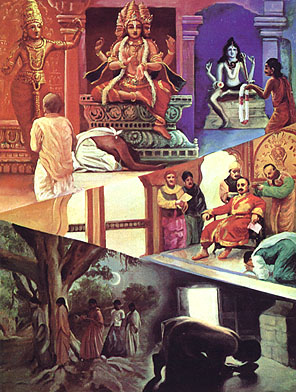
Worshipping the Supreme Lord (visuddha sattwam) and the Devas (sattwa
guna), worshipping powerful humans or demons (raja guna), worshipping ancestors
and ghosts (tamo guna) - worship according to different modes of nature
of the sadhaka.
"Those who are situated in goodness
generally worship the demigods. The demigods include Brahmä, Çiva
and others such as Indra, Candra and the sun-god. There are various demigods.
Those in goodness worship a particular demigod for a particular purpose.
Similarly, those who are in the mode of passion worship the demons. We
recall that during the Second World War a man in Calcutta worshiped Hitler
because thanks to that war he had amassed a large amount of wealth by dealing
in the black market. Similarly, those in the modes of passion and ignorance
generally select a powerful man to be God. They think that anyone can be
worshiped as God and that the same results will be obtained.
Now, it is clearly described here that those who are in the mode of passion
worship and create such gods, and those who are in the mode of ignorance,
in darkness, worship dead spirits. Sometimes people worship at the tomb
of some dead man. Sexual service is also considered to be in the mode of
darkness. Similarly, in remote villages in India there are worshipers of
ghosts.
We have seen that in India the lower-class people sometimes go to the forest,
and if they have knowledge that a ghost lives in a tree, they worship that
tree and offer sacrifices. These different kinds of worship are not actually
God worship. God worship is for persons who are transcendentally situated
in pure goodness. In the Çrémad-Bhägavatam (4.3.23)
it is said, sattvaà viçuddhaà vasudeva-çabditam:
“When a man is situated in pure goodness, he worships Väsudeva.” The
purport is that those who are completely purified of the material modes
of nature and who are transcendentally situated can worship the Supreme
Personality of Godhead." (Srila A.C. Bhaktivedanta Swami Prabhupada. Bhagavad
Gita AS IT IS 17:4. purport.)
"In the material world also, wherever
the Supreme Lord is personally
present is to be understood as
being the spiritual world. For example, the
Lord is worshipped in the temple
by pure devotees. The Temple is therefore
to be understood as being the
spiritual world." (Srimad Bhagavatam 4.11.26 Purport)


 ...About
the web-site: What's there - how to utilize
it...
...About
the web-site: What's there - how to utilize
it...
We have started this web-site and news-letter
for the purpose of sharing inspiration among like minded devotees, with
a like interest in serving the Lord. On the www.salagram.net/ site there
are many topics all referenced to shastra with the express purpose of helping
us all over the world to have Sadhu-sanga http://www.salagram.net/sstp-sadhusanga.html
So we have tried to create a sacred place in Cyber-space where devotees
can find refuge, can associate, gain inspiration, share inspiration, hence
it is Shaligram Tirtha, a Holy Tirtha in Cyber-space. Some of you may have
noticed the Warning........ it seems appropriate to some of us it be there
as many devotees were feeling they didn't want to express themselves or
reveal their "bhav" least people who had no such appreciation might misunderstand
- misinterpret - criticise what they saw or read due to their own vision/motivation/agenda.
So following the advice of shastra we are keeping our Ishthadevas hidden
while sharing mutual appreciation found in rendering some small service
to the Lord.
Those of you who haven't visited the
site recently, or for the many new persons on the mailing list, you will
find transcendental pleasure that there are so many resources and articles,
all of which you are welcome to download or copy for your personal use
and to inspire others. If however you find a published article there that
you would like to publish or if you have a site or some media whereby you
would like to on-share with others just check with me to see who holds
the legal copywrite if none are mentioned, as we don't want to offend anyone,
or do anything illegal, even with our zealousness to share nectar.
If you find any inspirational articles,
or items, or pictures relevant to this site please feel free to send them
to us. Please include all available references and details so that everything
can be appreciated fully by all.
If for some reason http://www.salagram.net/Sri-Shaligram-Tirtha.htm
isn't working or available then please go to the mirror site http://www.hknet.org.nz/Sri-Shaligram-Tirtha.htm
- and please remember to save these URLs in your Favorites (IE) or Hotlist
(Opera) Bookmarks (Netscape).


 ...
...
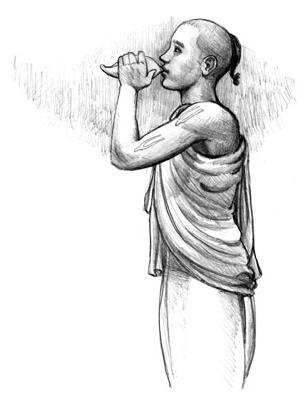
Latest Updates & Additions
@ A Glance
http://www.salagram.net/sstp-NEW.html
last updated 17th February 2005
In this section you can see all the
latest additions, new picture updates of all the various devotees and Silas
on the site.
We keep this page separate from the
main SEARCH page so that regular nectar
loving bees can quickly find their sweet flavoured source in what/Who has
been recently added to the site. SEARCH
and ARTICLES links and all other pages
are also updated simultaneously.







 for
Isthadevatas and Devotees on the site
for
Isthadevatas and Devotees on the site
http://www.salagram.net/sstp-SEARCH4devs.html
"There are no strangers, only friends
we are yet to meet" (unknown author)
To all those devotees who are receivers
of this first newsletter; if you still haven't sent in photos or introductory
descriptions or stories for the Sila in your care, that's okay, time is
not out, you can still send. We are continuously updating the pages, so
your sending pictures etc is never too late. Please send.
If you have Photoshop please "save
for web" to keep the size down, but if you don't have that too is okay,
just send, I can "save for web" also, if that will help. If you don't have
a scanner that too is no problem, please send me an e-mail and I'll give
you the address where you can post (snail-mail) your photographs, and there's
always disposable Fuji cameras if things get really tough...... Please
also view the article by Param Seva prabhu http://www.salagram.net/sstp-HELP.html
Search here for individual Sevaks and Deities World-wide.
A-B-C-D-E-F-G-H-I-J-K-L-M-N-O-P-Q-R-S-T-U-V-W-X-Y-Z


 ...Please
Visit the
...Please
Visit the  pages
pages
http://www.salagram.net/sstp-ARTICLES.html
As the late Bhakta George Harrison
so nicely put it in the preface of the Krsna Book, "The proof of the pudding
is in the eating", so please go to the Articles section and make good use
of all the links there. There's so much information and we hope and pray
that you find it as useful as we have. =>:-))
This section has to be seen to be believed.
We have tried, and had much success to find articles on almost every aspect
of Shalagram seva pujan. All articles are clearly marked and ready for
your perusal. We trust this serves you in this seva well.
http://www.salagram.net/sstp-ARTICLES.html



 The
Interactive Vaishnava Calendar page of Fasts,
Festivals, Functions and Feasts
The
Interactive Vaishnava Calendar page of Fasts,
Festivals, Functions and Feasts 
 http://www.hknet.org.nz/CalendarWhosWho-page.htm
( http://panjika.pagehere.com/
)
http://www.hknet.org.nz/CalendarWhosWho-page.htm
( http://panjika.pagehere.com/
)
Now you can view the FULL years
1999-2000 & 2000-2001 & 2001-2002 & 2002-2003 & 2003-2004
& 2004-2005 & 2005-2006.
All Calendar entries are explained
- Appearance or Disappearance days, festivals, fasts, feasts, etc., for
the Iskcon Gaudiya line
For notification of events, such
as ekadasi and major festival you might like to also receive the New Zealand
Hare Krishna Spiritual Resource network newsletter. You can also view those
newsletters current and archived on-line and join the mailing list HERE.
Vaishnava Calendar maker for your region - on-line:
http://www.iskcondc.org/cgi-bin/vcalndx.pl
Understanding the Festivals on the Vrindavan Calendar
http://www.naturalnirvana.com/Braja-Mandala/Braja-Mandal-Files/Braja-Vrindavan-Festivals.htm
Receive reminders of festivals and ekadasis
http://www.vaisnavacalendar.info


 The
Salagram Sila - some nice information from Shastra:
Shree Vishotara Purane Shree Saligram Sila-stotram
The
Salagram Sila - some nice information from Shastra:
Shree Vishotara Purane Shree Saligram Sila-stotram
Invocation: Yesay Shree
saligram strotra mantrasya Shree Vagban Hrishi Narayano Devata Anustup
Chhanda Shree Saligram strotra mantras jape bini yoga
I chant this saligram strotra matra in front of Lord Narayan
Hrishi and in sitting in good position.(on a Kush grass asan) offer water.
Yudhistiro Uvacha
King Yudhistir asked
“Shree Dev Dev devesa Devarchanamutamam
Tat sarbam srotaumichhami Bruhime Purushotamam / 1/
My dear Supreme Lordship Purushotam, I request you know
the significance of the saligram sila.
Shree Bhagavan Uvacha - The Lord Replied
“Gandakyam Chotare Tire Girirajshchya Dakshine !
Das Yojan Vistirnam Mahachhetra Vasundhara //2//
“Saligramo Vabet Devo Devi Dwara Bati Vabet
Uvayo Sangamo Yatra Mutistratrana Sansaya //3//
“Saligramo Sila Yatra Yatra dwara Bati Sila
Uvayo Sangamo Yatra Mutistratrana Sansaya //4//
The mountains known as the Himalaya are situated on the
bank of river Gandaki. In the south of this Himalaya a big and beautiful
tract of land is situated where you can find saligrams sila. This is the
place where Devi Dwarabati begins. This place is called by those who know,
Sri Mukti Kshetra.
“Ajanma Krita Papanam Prayaschitam Ya Ichati
Saligram Silawari Paphari Namastute //5//
“ Akal Mritu Haranam Sarvabyadhi Binasanam
Vishu Padodakam Pitwa Shirasha Dharyamyaham //6//
“Sankha Madhya Sthitam Toyyam Vramitam Keshavopari
Angalagnam Manukshanam Bramha Hatya Dikam Dayat //7//
Saligram Silas found here are very precious and significant.
These silas are considered to be directly Lord Vishnu Himself and the person
who worships or even keeps in the house or bathes the Salagram and drinks
water or pour those waters on their head, that man becomes free from all
sin and it prevents from untimely death. That person becomes free from
all sin and all material disease. The most feared sin of Bramahatya ( killing
of a Brahmin) is also washed away simply by worshiping the Saligram.
“Snano Dakam Piben Nityam Chakrankita Sirot Vabam
Partkshallya Sudham Tatoyam Bramha Hatya Byapohati //8//
“Agnistomasahasnani Vajapaya Satanicha
Samyak Phalama Bapnoti Visnornai Vedya Vakshina //9//
That person who does snan (bathing) of saligram with chakra
everyday get gets rid of all sin like Bramahatya, and if he drinks such
water daily gets the equal boon of thousand of havan (fire sacrifices)
of Lord Vishnu.
“Naivadyayuktam Tulsim cha Misritam Vishesta Pada Jalen
Vishnu
Yoshnati Nityam Purato Murari Prapnoti Yazya Uta Koti
Pundyam //10//
The person, who worships saligram with Tulsi leaf daily,
gets the boon of million Yajna also.
Khandita Sphutita Viina Vandi Dakdhya Tathi Va Cha
Saligram Sialyatra Tatra Dosho Na Vidyate//11//
Even if a Salagram is damaged or broken, all sila are
good to worship
Namantra Pujanam Naiva Natirtham Na cha Bhabanaa
Na stutir Na uppachars cha Saligram Silar cha ne //12//
Bramha Hatya Dikam Papam Manobak Karya Sambhamam
Shirgram Nachyati Tatsarvam Saligram Silrchana//13//
With out worship, with out offering any sweets or with
out any pilgrims - only chanting this saligram mantra is enough to
wash away all sins and is the fulfillment of all desire.
“Nanabarna Mayam Chiva Nana Bhogena Vestitam
Tathavarprasadena Laxmi Kantam Balamhayam //14//
“Narayanorbhabo Dev Chakramadya Cha Karmana
Tathavarprasadena Laxmi Kantam Balamhayam//15//
There are various kinds of size and shape of saligram
in which Lord Vishnu is situated representing all the different incarnations.
“Krishane Sila Taneyatra Susmam Cakram Cha Drisyate
Saovagyam Santatim Dhatye Sarva Sakshaym Dadhaticha//16//
Good Luck increases and one gets satisfaction from children,
and in every way in every aspect, all good enters one's life by worshipping
saligram black in colour with little chakras.
Vashu Devschya Chinhani Distwa Papai Pramuchyate
Sridhar Sukare Bame Harivbarnatu Disyate//17//
“Varaha Rupenam Devam Kurmangai Rapi Chinhitam
Gopadam Tatra Dissheta Varaham Vamanam Tatha //18//
A person who gets the chance to see the Vasudev sila,
that person he became free from sins. Shreedhar, Sukar, Vamanadev, Harivarna,Varaha,
Kurma and lots of other type of saligram are available also. Some Saligram
has marking of cow's foot marks and some that of Narshimha Avatara (half
lion half man).
“Pitavarnam Tu Devanam Rakta Varnam Vayabhaham
Narashinho Vawet Devo Mokshadam Cha Prakrititam//19//
Sankha Chakra Gada Kurma Sankho Yatra Pradisyate
Sankha Varnaschya Devanaman Vame Devaschya Lakshanam//20//
“Damodarm Tatha Sthulam Madhya Chakram Pratisthitam
Purna Dwarena Sankrina Pita Rekha Cha Drischyate //21//
“Chhatrakare Vabet Rajam Vartule Cha Mahasreeya
Chipite Cha MahaDukham Sulagretu Ranam Dhrubam//22//
Yellowish Saligram is very auspicious as Lord Himself
(Pitambara) but reddish saligram is considered to bring fearful situations
and is dangerous to worship. The sacred symbols of Sankha (conch), Chakra
(disc), Gada (club), Kurma (tortoise) are printed on the saligram
stones. Saligram with Sankha (conch) sign is considered to be Vamanrup
(Vamandev) of Lord Vishnu, where as chakra in the middle is consider as
Damodar saligram. Saligrams of different shapes; round, umbrella shape
which has white lines are also available; worshipping this kind of saligram
gives wealth and reputation in society. Flat shaped saligram creates sorrow
in a family and saligram with sharp front side creates war - fighting and
tension in family.
“Lalate Shesha Vogastu Siropari Sukanchanam
Chakrakanchanavarnanam VamaDevaschya Lakshnam//23//
Vamaparbe Cha Bai Cakre Krishna Varnas tu Pingalam
Laxinarshimhadevanam Prithak Varnastu Drisyate//24//
Saligrams which have chakra around the head or in the
forehead and rest parts are clean and smooth is considered very auspicious
and this type is to be considered as Vamandev sila. Yellowish or black
in left side with a chakra is consider as Laxmi Narshimha sila.
Lamboste Cha Dalidram Syat Pingale Hani Revacha
Lagna Cakre Vabet Baydhir Bidare Maranamdrubam//25//
Worshipping a long shape sila create poverty, and saligram
having lagna (rising) chakra create long term chronic diseases even death.
Padom Dakamcha Nirmalyam Mastake Dharayet Shada
Visnor Dristam Vakshitabyam Tulsi Jal Misritam//26//
Kalpa Koti Sahasrani Vaikunthe Basate Sada
Saligram Sila Vinur Hatya Koti Vinasanam//27//
Any person who offers a Tulasi leaf while worshipping
the saligram gets salvation and can stay at Vaikuntha (the place where
Vishnu live - means free from anxiety) for million years.
Tasmat Sampujayet Dhyatwa Pujitam Chapi Sarvada
Saligram Silas Trotram Yah Pathecha Dijotam//28//
Sa Gakshet Parmam Sthanam Yatra Lokeshworo Hari
Sarva Pap Binir Muktwa Vishnu Lokam Sa Gashati//29//
Therefore always worship saligram, and chant saligram
stotra which is very beneficial for mankind. We can get one a higher position
on Vishnu Lok (Vaikuntha) simply by doing so. All sins will also be destroyed
and it is guaranteed that one gets to Vishnulok simply from this process
of worshiping the saligram.
Dusovataro Devanam Prithak Varnastu Disyate
Ipsitam Labate Rajyam Vishnu Pooja Manukramat//30//
Kotyohi Vramhahatyanamgamyagamya Kotaya
Ta Sarva Nasamayamti Vishu Nai Vidya Vakshanat//31//
Vishno Pador Dakam Pitwa Koti Janmaghanasanam
Tasma Dasta Gunam Papam Ghumou Vindupatnat//32//
There are various types of description available for Lord
Vishnu’s ten primary incarnation therefore the Lord’s incarnation Shree
Saligram’s worship, the Prayer to the Saligram and drinking the Lord's
bathing water wash away sins of million lives and one gets great prosperity,
wealth and reputation through this, so everyone everywhere the Saligram
should be worshiped.
Iti Shree Vishotara Purane Shree Saligram Sila-stotram
Sumpurnam!!
used courtesy of Mukunda Khatiwada http://www.saligram.org/

 Srila
A.C. Bhaktivedanta Swami Prabhupada's words
of encouragement:
Srila
A.C. Bhaktivedanta Swami Prabhupada's words
of encouragement:
(These words are so to the point and so instructive that I have to
leave them here for this newsletter to. In fact I can't share them or tell
enough people of the simple genius of these words. Mutual appreciation
and equilateral acceptance of service for Krishna. It truly makes a "house
in which the whole world can live peacefully.")
Los Angeles - January 1975.
My dear Satsvarupa Maharaja,
Please accept my blessings.
I am in due receipt of your letter dated Jan.
5th, 1975 and have noted the contents. Thank you very much for doing your
work so nicely. I was very pleased to receive the review on the 1st volume
of the third canto of Srimad-Bhagavatam written by professor Mehta from
the University of Windsor. If you can send more similar reviews on my books,
I would very much appreciate it. I am keeping a folder on such things and
we can print a small book to distribute that will contain such reviews
so that people will see what a great impression our books have on the intelligentsia
of the world.
Regarding your question about the controversial
talks going on, this kind of talk is not befitting my advanced students.
This is childish. In Krishna's service, there is no inferior and superior.
Deity worship is just as important as book distribution. It is not material.
As mentioned in the Bhagavatam.
sravanam kirtanam visno smaranam pada-sevanam
arcanam vandanam dasyam sakhyam atma-nivedanam
Sravanam kirtanam is the beginning--to chant
and hear. Book distribution is under this category of sravanam kirtanam.
The next item is smaranam. If somebody simply remembers the Supreme Lord,
that is also as good as sravanam kirtanam. Then there is arcanam. That
is also as good as the others, but one who simply becomes engaged in arcanam
and does nothing of sravanam kirtanam, his position becomes in the material
field. Any one of the nine processes is as good as the other. There is
no question of inferior or superior. But out of all of them sravanam kirtanam
is very important. Sri Caitanya Mahaprabhu while instructing Srila Rupa
Gosvami, has said how the seed of devotional service sprouts and increases
by watering the root by the process of sravanam kirtanam. So, these two
items are very important in devotional service, but that does not mean
that the other items are inferior. Srila Jiva Gosvami has stressed kirtanam
especially in the age of Kali. Even if there is arcanam for sanctifying
the contaminated mind, it must be accompanied by sravanam kirtanam.
So, you are all advanced
students. You should understand the importance of each and every item of
devotional service. Do not make any misunderstanding by devaluating any
of the spiritual activities. You are one of the advanced students. One
who distinguishes a particular type of service as inferior or superior,
he does not know the value of devotional service. It is all transcendental.
Whatever item is suitable, that is accepted as very elevated. Just like
Maharaja Pariksit. He simply listened to Sukadeva Gosvami. That is sravanam.
And Sukadeva Gosvami simply narrated Srimad-Bhagavatam. This is kirtanam.
Prahlada Maharaja simply contemplated--smaranam. Prthu Maharaja simply
did deity worship--arcanam. Arjuna only remained as friend of Krishna--sakhyam.
Hanuman remained only engaged in carrying out the order of Lord Ramacandra--dasyam.
And Bali Maharaja surrendered everything to Krishna--atma-nivedanam. So,
any devotee executing any one of the nine is transcendentally glorious.
One devotee may be proud that his process of service is the best. That
is not inglorious. This is called transcendental competition. Everyone
should feel proud of his particular type of devotional service, but that
does not mean that other types of service are inferior. Everyone should
feel proud of becoming sincere servant of Krishna, but the pure devotee
never minimizes the importance of other devotees. Krishna is the enjoyer
of varieties of service. It is not stuck up with any particular type of
service. Krishna takes pleasure with devotees even by fighting service.
When Grandfather Bhisma was trying to injure the body of Krishna by sharpened
arrows, in full devotion in the mellow of chivalry, Krishna was feeling
the piercing of the arrows as good as worshiping him with soft rose flowers.
The conclusion is thatRemembering Srila Prabhupada - .ems everyone should
be very very sincere. There is no more the question of inferior or superior.
I hope this meets you in good health.
Your ever well-wisher,
A. C. Bhaktivedanta Svami
This letter is kindly borrowed from the Prabhupad Uvacha series of nectar
snippets from Srutakirti prabhu's diary. If you'd like to receive such
snippets on a daily basis please send a message to mailto:krpamaya_gauranga@hotmail.com
with the positive affirmative "Subscribe" in the Subject area.
Please Chant: Hare Krishna Hare Krishna Krishna
Krishna Hare Hare Hare Rama Hare Rama Rama Rama Hare Hare And Be Happy
If you want to introduce anyone else in reading Srila Prabhupada Nectars,
please send their eMail addresses to krpamaya_gauranga@hotmail.com








Sila Katha - Swadhyaya...
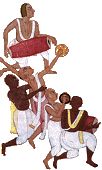
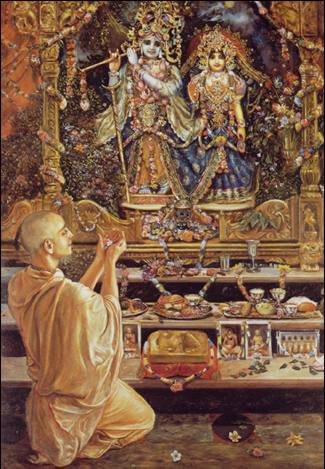

 Salagram kosha
Salagram kosha
by SK Ramachandra Rao
Chapter Five
(From Sri-tattva-nidhi)
Identification of Shaalagraama
pages 137 - 174.
Identification of Salagramas
The following account is taken from Sri-tattva-nidhi, an encyclopedia
work in Sanskrit compiled by the late Maharaja of Mysore, Krishnaraja-wodeyar
III (1780-1865). This monumental work in nine sections (which are called
‘treasures’, ‘nidhis’) is profusely illustrated by miniature paintings,
and deals with the iconographical lore, subjects like Agama, Jyotisha,
Sangita, and games and pastimes. The work, not yet seen in print, is in
the nature of a compilation from hundreds of ancient and medieval manuals
and texts. In the Vaishnava-nidhi section of this work, is the account
on salagrama-stones as anionic emblems (symbols) of Vishnu, which is reproduced
below, with a running translation in English.
The authors of this work has preferred the expression ((dental) ‘saligrama’,
which is also the more popularly used form in South India as well as North
India, to the more correct ‘salagrama (palatal). And the account of these
sacred stones has been taken from Narasimha-purana (Brahma-Narada-samvada).
It may be seen that the account given in Sri-tattva-nidhi is rather haphazard
and ill-organized, as compared with, for instance, the Salagrama-pariksha
of Anupa-simha, who was the Maharaja of Bikaner. The text of the relevant
and corresponding portions of Salagrama-pariksha have been given in the
Appendix. This text, in contrast, is well-organized in three distinct sections
(1) murtis relating to the ten avataras; (2) murtis relating to the twenty
four forms (chatur-vimsati murti); and (3) miscellaneous forms (prakirna).
Although all these forms are dealt with in Sri-tattva-nidhi, the descriptions
are confined to those given in Narasimha-purana, whereas Salagrama-pariksha
provides information from other puranas also.
Not only the order of deity-specific salagramas given here is haphazard,
but some of these forms are repeated during the course of narration more
than once, with different descriptions. While the major part of the text
is taken from Narasimha-purana it is likely that passages have also been
incorporated. The text, however, is unsatisfactory, especially when compared
with words like that of Anupa-simha. But the matter here represents the
South Indian tradition with regard to the Salagrama-lore.
(Narada tells Brahma that he was enlightened by the letter on many topics,
and requests him that he be pleased to tell him about the other Salagrama-stones;
about their origin, characteristics like colour and field, the differentiation
in respect of divine form, and their suitability for purposes of worship.)
(Brahma proceeds to tell Narada about the salagrama-stones: their origin,
identification, colour, field and other details.)
There is in the country of Avanti, a sacred mountain around which is
the site which is the source of all the salagrama-stones.
Merely to remind oneself of this sacred site is to get rid of all the
sins that have accumulated in the past. It is here that the river Gandaki,
which destroys all sins, flows. By a touch of the waters of this river,
one obtains residence in the realm of Vishnu. At the foot of the mountain
in this site is a great stream known as Chakra-tirtha. The source of that
river is said to be Vishnu himself; and in that mountain-stream, the god
who wields the discus dwells. He abides here along with his consorts Lakshmi
and Bhu, and in every stone that occurs in this sacred site. In the bowels
of the rocks free from wind and cold the salagrama-stones are formed, with
all adorable characteristics. On auspicious moments, these sacred stones
get formed by the grace of God. The formation of spiral marks, the chakras,
in these stones is explained as follows:
After thousands of years, the animal called vajra-kita (the adamentine
worm) was born in these stones; the animal was in fact the form which Vishnu
himself assumed.
Having entered into the bowels of these stones, the animal, golden coloured,
mighty and brilliant like a flash of lightning, making a sweet noise, carves
out the marks of discus of numerous kinds and various other marks with
ease in the stones. The animal, who is Vishnu himself, the lord of Lakshmi,
resides inside these stones for countless years; the presence of Godhead
is unbroken here.
By a mere look at these stones, all the sins that one had accumulated
will at once get destroyed.
The variety of forms, colours and other characteristics of the salagrama-stones.
The sacred stones may be white, yellow, red, black, green, tawny or
ash-coloured; they may contain stains, and they may be multi-coloured.
The colours might be excessive or faded; the colours may otherwise
be difficult to determine. The stones occur thus in many colours and forms.
The salagrama-stone is described as the ‘field’ for the presence of
Godhead. The differentiations in this regard are dependent on the colours.
The Vasudeva-salagrama is white in hue; the Hiranya-garbha-salagrama is
yellow; the Pradyumna-salagrama is red. Vishnu-salagrama is black
stone; Narayana-salagrama is greenish in colour; Narasimha-salagrama is
red; and Vamana-salagrama is like the atasi flower in colour (flax, Linum
usitatissimum)
The colours have their own effects and influences.
The ash-coloured salagrama stone is especially suitable for worship
by ascetics. The stones which are stained bring decay and destruction,
the multi-coloured stones are also unfit for worship, unless it be Ananta-salagrama.
Highly coloured stones cause misery; the faded colours destroy the lineage;
the colours which are indistinct and uncertain make for death.
The tawny-coloured stone is consort-killer; the bluish-stone brings
wealth; the black-stones cause nourishment and prosperity; and the red-stone
brings in sovereignty.
Excessively red-stone, however, deals death; the fair-coloured stone
(viz. White) bestows wealth; multi-coloured stone makes for prosperity,
while the faded colours are not useful when worshipped.
There is some confusion here with regard to the expression ‘bahu-varna’.
White coloured stones facilitate the obtainment of emancipation, and
the stone with indistinct and uncertain colours destroy everything.
The salagrama stones differ with regard to their circumference (parimana),
which is measured in terms of the size of the aperture.
The wise one will tie round the middle of the salagrama-stone a thread;
and if the aperture is located at the spot which marks one-eight of the
thread’s length, then the stone is of superior variety; it may also be
of the middling variety. However, the stone having an opening in the one-third
part is to be rejected. (However, Brahmanda-purana has a different prescription:
There are different effects in terms of locations of operators. If the
aperture is downward, it is terrible; the aperture on top will be useful
only in magical rites of driving away the enemy; The apertures being even
are especially meritorious, while the aperture on the sides will take away
fortune.
If the aperture is crooked, it causes disease; if long-mouthed it devours
everything (viz. Makes one impoverished). One should carefully examine
the stone before ascertaining the deity-specification.
The manes of the ten incarnatory forms of Vishnu:
The forms of Vishnu are: Matsya, Kurma, Narasimha, Rama (son of Jamadagni;
viz. Parasu-rama), Rama (viz. Bala-rama), Rama (son of Dasaratha), Buddha
and Kalki.
The characteristics of the salagrama-stones, which are deity specific:
The Matsya-murti-salagrama has the form like the head of the fish; a
chakra is seen on the face; there are also marks of sri-vatsa, dots and
scratches resembling vanamala (garland of wild-flowers)
The Maha-kurma-murti-salagrama is round, shaped like a tortoise, and
has marks of vanamala, lotus and discus; its colour is green (viz. Of tree
Butea ftrondosa); and it has golden spots.
The Varaha-murti-salagrama is long-mouthed, is blue-black in colour,
has an encircling mark of earth, and is distinguished by a shining chakra
at the opening.
The Buddha-murti-salagrama has two apertures, and two chakras in the
interior. The chakras are upward-inclined at the head, or they are at the
sides. The stone may be multi-coloured.
The Narasimha-salagrama has an elongated mouth, tawny-hued, a longish
chakra and a big belly (viz. Middle portion). This stone is suitable for
worship by ascetics.
The Lakshmi-Narasimha-salagrama has a chakra on its left side, is black
in colour and has spots (viz. Dots). Its worship makes for worldly prosperity
as well as emancipation.
The Vamana-murti-salagrama is shining blue in hue; it is small in size
and perfectly round in shape; it has marks of vana-mala and lotus.
The Parasu-rama-murti-salagrama is distinguished by the line-scratches
resembling an axe; it is dark blue-green like the blade of the durva-grass;
it is high in stature and is adorned with a chakra at its navel.
The Sri-rama-murti-salagrama is large, elongated and has spots on its
body; there are also line-markings resembling bow and arrow; there is a
chakra at the navel, and dark stone has many fissures.
The Bala-rama-murti-salagrama has marks of the plough-share, and of
the pestle-like weapon on it; it is whitish in colour, and has line-scratches
of vana-mala; there are also dots like honey drops. This is the abode of
Samkarshana.
The Srighana-murti-salagrama is white in colour and exceedingly smooth
to touch. It has a thousand (viz. Many) spots on the surface, and also
a chakra.
The Kalki-murti-salagrama is recognized by the line-markings resembling
a horse, and the weapon called Kunta (lance). It is white in colour, and
has a long mouth.
The Sri-krishna-murti-salagrama has markings of the five weapons (conch
called Panchajanya, discus called Sudarsana, mace called Kaumodaki, bow
called Sarnga, and sword called Nandaka), vana-mala and lotus; is has a
minute chakra.
The Sri-gopala-murti-salagrama has the markings of the five holy weapons
(mentioned above); it has no apertures; it is either round in shape or
elongated; a vana-mala mark is seen on it.
This salagrama can have identification marks of a single deity or of
a combination. It may be longish in shape, and is characterized by a big
belly (viz. Middle portion being big); it has scratches resembling flute-openings.
The Dadhi-vamana-murti-salagrama has a downward chakra at the top which
are spots like honey drops, the stone has a bluish tinge as well as reddish
hue.
The Dadhi-gopala-vamana-salagrama has a chakra on top, with spots like
honey-drops at its upper end.
The Santana-gopala-murti-salagrama has marks of cudgel and horn (which
cowherds carry) on its sides, and at the head position can be seen the
mark of a flute. The worship of this stone ensures progeny.
This stone is blue in colour and elongated in shape; it has an aperture
which resembles the elephant-goad, a chakra.
The Pradyumna-murti-salagrama is of the colour of a hibiscus flower
(viz. Red) and is marked by lines and scratches resembling vana-mala, bow,
arrow and lotus. Its worship bestows whatever one longs for.
The Aniruddha-murti-salagrama has the same characteristics as the above
(viz. Pradyumna murti), but is recognized be an aperture with a minute
chakra, and by marks of golden and silver lines.
The Hayagriva-murti-salagrama has the form of a ripe jambu-fruit (rose
apple, Eugenia Jambolana), with a face in the shape of an elephant god;
it has also longish spots on its body.
The Sridhari-murti-salagrama shines like fresh green grass, has uneven
chakras and there are marks on it resembling vana-mala.
The Lakshmi-narayana-murti-salagrama has a low or depressed look, and
is perfectly round, and cold to touch; it has a chakra on its head; there
are two apertures and there are four chakras either to the left or to the
right.
The Padmanabha-murti-salagrama has a lotus-like chakra at its navel,
and is of the colour of a rose apple (Eugenia Jambolana).
The Govinda-murti-salagrama is dark blue like the blade of a fresh durva
grass; it has ten apertures and twenty chakras; and there are scratches
on its body which look like vana-mala. The worship of this stone secures
the fulfillment of all desires.
The Visvarupa-murti-salagrama is known by its twelve apertures and twenty
four chakras. Its worship will bring about worldly prosperity as well as
final beatitude.
The Ananta-murti-salagrama is always cold to touch, but shines like
a blaze of fire; it has an even number of minute chakras, with marks of
the classical five weapons of Vishnu (conch, discus, mace, bow and sword),
and also of Sri-vatsa-mark on the chest.
The Lakshmi-narayana-murti-salagrama is hard to obtain, and its worship
quickly fulfills ones desires. At the entrance to the aperture are lines
which resemble the flying bird Garuda (the vehicle of Vishnu).
The Narayana-murti-salagrama is recognized by the shape of the serpent’s
hood that seems to surround it. Its worship secures the fulfillment of
whatever one seeks for.
The Damodara-murti-salagrama is longish in shape, and brilliant in appearance;
there are marks on its body of conch, discus, mace and vana-mala.
The Trivikrama-murti-salagrama is longish in shape, and brilliant in
appearance; there are marks on its body of conch, discus, mace and vanamala.
The Janardana-murti-salagrama is characterized by its blue colour and
marks of conch, discus and lotus; it is cold like ice; and has a
shape like a spear.
The Vasudeva-murti-salagrama has the appearance of tranquillity, and
shines like moon-light; it bears the marks of the five weapons of Vishnu
(conch, discus, mace, bow and sword), and has a chakra at its navel.
The Vishnu-murti-salagrama has the dark colour of the Vishnu-kranta
flower (Clitoria Ternatea or Evolvulus Alsinoides), the marks of the five
weapons of Vishnu (mentioned above), and also of vanamala and lotus.
The Achyuta-murti-salagrama is bluish in hue and large in size; it is
smooth and has minute chakras; it has marks of vanamala on its body.
The Upendra-murti-salagrama is also shining blue in colour, with marks
of conch, discus and mace on its body. Its worship will cause happiness
and good fortune.
The Siva-nabha-murti-salagrama is roundish like an elephant’s body;
and in the central portion thick lines are seen. It is hard to obtain,
but its worship secures all desires.
The Hiranya-garbha-murti-salagrama is blue-black in colour and cold
to touch; it has no apertures, but it contains gold within (viz. It has
spots in golden colour in the middle portion of the stone).
The Madana-gopala-salagrama is partly black in colour and partly reddish;
it has a long aperture on its left side; and there are marks of conch,
discus, bow and moon.
The Janardana-murti-salagrama shines like blue water-lily (utpala, Nymphala
caerulea); it is recognized by the vana-mala mark which goes round the
stone.
It is elsewhere described as having six apertures and twelve chakras,
slippery to touch, and marked by vana-mala.
The Lakshmi-narayana-murti-salagrama has two chakras on top and two
chakras at the bottom.
The Sriman-narayana-salagrama has two chakras on each of its sides.
The Sudarsana-murti-salagrama is round in shape or sometimes oval; there
is a single chakra seen at the aperture; and there are spots on the body
of the stone.
Elsewhere, this is described as equipped with two chakras at the top,
and as exceedingly ferocious in aspect, and as such worthy of worship only
by ascetics.
The Vanamala-murti-salagrama is of tawny hue, and has an aperture at
the sides of which are fang-like structures and inside which are two chakras;
the aperture is crooked, and by its side is the vanamala mark.
The Maha-jvala-nrsimha-murti-salagrama is thick in shape, blue-black
or tawny in colour, and has a gaping mouth (aperture). This is fit for
worship only by mendicants.
The Siva-nabha-murti-salagrama has a linga-like form on top where there
is also an aperture; it is perfectly round in shape and cold to touch.
It is auspicious and secures all prosperity.
The Buddha-murti-salagrama is muddy coloured and has spots on it; the
chakra is there in the aperture, but unseen; the chakra also is dark gray
in colour.
The Lakshmi-nrsimha-murti-salagrama is tawny in hue, and inside its
aperture is a large chakra within which is another chakra, minute in size.
The Sveta-varaha-murti-salagrama has a long snout, and one tusk; it
is whitish in colour and exceedingly clear; there is but a single mark
on its body which resembles vanamala.
The Bhu-varaha-salagrama has a raised body with a head shaped like an
elephant goad; there is a chakra at the bottom, and near it can be seen
a structure like the single tusk. It is an auspicious stone.
The Kurma-murti-salagrama is thick and compact in structure, blue-black
in colour, variegated hue, tawny or black; it has chakras.
The Hrshikesa-murti-salagrama is dark blue (or black) in colour, soft
to touch; it has five apertures and ten chakras.
The Keshava-murti-salagrama is blue black in colour with minute chakras;
it has golden and silver spots, and a mark resembling vanamala.
The Achyuta-murti-salagrama is extremely cold to touch, and has a small
aperture; it has a chakra on the surface and two chakras within the aperture.
The Vaikuntha-murti-salagrama is blue-black in colour and soft to touch;
there are line marks of eight weapons of Vishnu, and also a mark of vana-mala;
there is an aperture like the lotus stalk.
The Vishtara-sravo-murti-salagrama is a large one, elongated in shape
and has apertures on both of its sides; there is a chakra, and also the
mark of vana-mala going round.
The Hiranya-garbha-salagrama is moon-like in appearance, slippery to
touch, and large in size, raised on top. There is a chakra at the entrance
of the aperture.
The Tri-murti-salagrama is characterized by the marks resembling conch
and discus (emblems of Vishnu), snake and battle axe (emblems of Siva)
and lotus and water-pot (emblems of Brahma), and marks of three garlands.
The Kurma-varaha-murti-salagrama has a chakra with two dots or the mark
of conch; and there is another minute chakra nearby. This is difficult
to procure and its worship will secure the fulfillment of all desires.
The Matsya-murti-salagrama has the shape of a fish, and is spotted;
there is the mark of shakti-linga (viz. Trinagle) at the head which is
unevenly situated or at the place where the mouth would be located.
The Varaha-murti-salagrama is dark-blue in colour thick, and marked
with three lines. Its worship promises the fulfillment of all desires.
The Kapila-narasimha-salagrama has a large chakra at the place where
the tusk would be located; the colour of the stone is tawny, and there
can be seen on the stone the mark of vana-mala. This must be worshipped
only by celibates for worldly prosperity or for salvation.
The Vamana-murti-salagrama is of the colour of flax-flower (Linum usitatissumum)
and is endowed with spots on the top; there are scratches resembling ear-rings;
and also a spot on the head. The stone is small and round.
The Dadhi-Vamana-murti-salagrama is a small one and perfectly round;
it is black in colour and has spots on top. There is a chakra in close
proximity to the aperture. This is hard to get, but when worshipped it
secures all desires.
There is another variety of this salagrama which is small and has two
spots; it is dark in colour and extremely greasy (or smooth); there is
on it the mark of vana-mala. It is an auspicious stone, facilitating worldly
prosperity as well as salvation.
The Lakshmi-nrsimha-murti-salagrama is black coloured and spotted; on
its left side are two chakras. The worship of this stone secures prosperity
here and liberation hereafter.
The Rama-murti-salagrama resembles in its colour the kadamba flower
(Naulea Cadamba, viz. Orange) and is spotted; there are marks on it of
bow, arrow and lotus. It is pleasant in appearance, but difficult to obtain.
Its worship is capable of fulfilling all desires.
The Sri-rama-murti-salagrama is like hen’s egg in shape, and is blue-black
in colour; the rear portion is raised; at the back are scratches resembling
a bow, the wish-fulfilling tree and royal parasol; and criss-cross lines
suggesting a quiver. This is a rare salagrama.
The Sita-rama-murti-salagrama has a shape that resembles a hen’s egg,
and has an opening at the bottom, with marks like ear-rings. At the entrance
are evenly situated chakras; and the mark of the wish-fulfilling tree is
also there. There are chakras at the front and on the left side and line
scratches.
The Gopala-murti-salagrama has the shape of a jambu-fruit (rose apple),
and is black in colour; there are also spots. At the rear there is an aperture,
and a mark of ear-rings (makara-kundalas); on the forehead of the stone,
slanting to the left are the mark of he arrow and bow, with spots. This
sacred stone is capable of eliminating enemies and fulfilling all desires
when worshipped.
One who has no progeny will procure progeny; and the stone is all auspicious.
The Brahma-murti-salagrama (Parameshthi) is whitish in hue, and perfectly
round; it may also be yellowish. It has a single chakra and mark of a lotus;
and at the rear portion is an aperture.
The Vasudeva-murti-salagrama is small and round, very much like an areca-nut;
there are two chakras evenly located at the entrance of the aperture. However,
there are no chakras in the interior. It is rather whitish in colour and
brilliant in appearance. When worshipped, it can help avoid untimely death;
and it will secure all desires.
The Maha-vishnu-murti-salagrama is pleasant in appearance, and the spiral
mark in lines is seen on its surface. It shines brilliantly, and is black
in colour. It is an auspicious stone and will remove all fear of death.
The Narayana-murti-salagrama is blue-black in colour, and has a chakra
at the navel, which is also raised. There is long line-marking on its surface
and the mark of vanamala in gold.
The Lakshmi-narayana-murti is of yellowish hue, and its left side is
rounded; there are four chakras surrounded by a long time. There are markings
of pestle, sword, bow, vanamala, conch, discus and mace on the face and
at the navel. The stone is suitable for all prescribed rituals; it will
cause prosperity, and accomplishment of ones desires.
The Sridhara-murti-salagrama is recognized by the prominent marking
of vanamala; the stone’s colour is very much like the Kadamba flower (Nauclea
Cadamba, viz. Orange). Its worship secures all attainments
The Samkarshana-murti-salagrama is characterized by two chakras situated
in the same spot, and by the front portion being large. The colour of the
stone is reddish, and it is beautiful to look at.
The Pradyumna-murti-salagrama is of bright yellow colour; there is a
minute chakra, and there are numerous apertures in the elongated body of
the stone.
The Vishnu-murti-salagrama is bluish in colour, round in shape and has
a chakra which is large in size. It may otherwise be blue-black in colour.
It is a beautiful salagrama.
The Krishna-murti-salagrama is recognized by a long line in the middle,
which resembles the mace. The worship of this stone helps one to acquire
worldly prosperity and also obtain emancipation.
The Kurma-murti-salagrama is raised on the rear side, and is adorned
by white hood-like structure and marked by a hoof (foot mark of horse).
It has black spots but otherwise clear. The stone is suitable to be worshipped
on all auspicious occasions.
The Ananta-murti-salagrama is distinguished by the marking of the serpent
hood. The banner-like marking is seen in the middle, accompanied by a line.
The stone is a large one, shaped like a serpent; and has seven chakras.
Another variety of Ananta-murti has eight or ten chakras, which indicate
its superior merit. It may also have thirteen or fourteen chakras, which
enhance its value. The stone is yellowish, bluish or variegated in colour.
It has markings of discus, conch, mace, lotus and vanamala. The worship
of this stone is calculated to secure all prosperity.
The Trivikrama-salagrama is shaped like a hen’s egg; it has a chakra
on the top-position; there are two other chakras and on one side of the
stone is larger on the other. There are markings of flag, conch and ploughshare;
there are also spots. Its worship helps avoid untimely death.
The Lakshmi-gopala-murti-salagrama is also shaped like a hen’s egg,
but has markings and ear-rings. This stone is an extremely rare one; and
its worship assures progeny, prosperity and salvation.
The Sri-hari-murti-salagrama is a large one and its colour is that of
copper (or red).
The Balabhadra-murti-salagrama, which is worshipped for obtaining celebrity
and cattle wealth is blue-black in colour and its shape is that of a parasol;
it is smooth (greasy). It is characterized by animating opening, by a spot
and by red lines. Its fore-part is bulky, and its body is soft and shining.
The Gopala-murti-salagrama, which is a very rare one, is worshipped
for obtaining progeny, increase of cattle-wealth and emancipation.
The Lakshmi-gopala-murti-salagrama is shaped like parasol, and is extremely
unctuous: it has no apertures, but spotted. It is large, heavily and brilliant.
The Varaha-murti-salagrama is dark in colour (blue-black), has the rear
part raised, and is adorned by a golden spot at the back. There are two
chakras evenly located; and at the bottom is a minute chakra.
The Janardana-murti-salagrama is distinguished by four chakras.
The characteristic features of some salagramas representing deities
like Sudarsana are given below:
The Sudarsana-murti-salagrama has but a single chakra, while the Lakshmi-narayana
murti has two chakras, the Achyuta-murti three and the Janardana-murti
four. Vasudeva-murti has five chakras, while Samkarshana has six, Varaha-murti
seven, Purushottama-murti eight, Narasimha-murti nine, Vamana-murti ten,
Pradyumna-murti eleven, and Ananta-murti twelve. The supreme spirit abides
in other multi-chakra-stones also.
The especial benefits of worshipping these different varieties of salagramas
are narrated as under:
The Hiranya-garbha-salagrama brings all good fortune to the worshipper;
it is like worshipping a thousand Shiva-nabha salagramas. It assures worldly
prosperity.
There are, however, some salagramas which are difficult to identify
with specific deities.
There are many deities in a salagrama as the forms of Vishnu are (viz.
Innumerable). It would be impossible to separately identify all the forms
of deities in salagrama even in a million years.
Now then the forms of the salagramas that must be avoided (viz. Not
worshipped) are given:
The salagrama-stones which have irregular angles, which are burst, burnt,
stained, or warm to touch must be avoided, as also those without chakras,
or those which have been embrocated (rubbed and frayed), or which have
crooked apertures.
Likewise the stones with numerous chakras, crooked chakras and chakras
at the bottom, must be avoided.
The stones with many arrow-like lines, or with chakras which cannot
be deciphered at all; the stones which are shaped like unripe bread-fruit
(Artocarpus integrifolia) or like the deep-brown vegetable (Caculus melanoleucus).
The stones which are fettered (clasped or joined) or obstructed, the
stones which have a cruel, terrible and awesome aspect, and the stones
which have crooked snouts must be avoided.
The stones which are broken or burst open, the stones which are burnt,
and the stones which are triangular in shape must be avoided, as also those
which have internally split, and damaged; and the stones which have many
scratches and fissures must also be avoided.
The effects of worshipping the salagramas which are to be avoided, are
given below:
Worshipping a broken, burnt or warm stone makes one become impoverished;
by worshipping joined stones, tangled chakras or a triangular stone, one
will witness the death of relatives.
By worshipping a stone which has suffered an internal bursting, the
worshipper’s relatives or children will die. By the worship of stones with
no markings at all, one loses his wealth. By worshipping a stone which
has a ferocious aspect, one gets great sorrow, and his family will be destroyed.
The salagramas must, therefore, be carefully examined with regard to
their worthiness for worship.
In the salagramas abide all the fourteen realms, and therefore when
one gifts the salagramas to others, God will be pleased.
However, one must accept a salagrama which has already been worshipped,
and one must gift the salagrama after worshipping it. Both the receiver
and the donor will obtain merit. But one who sells or buys salagramas will
only be sinning.
The place where Salagramas are kept and worshipped is pure by that very
act.
There is no offence or transgression in keeping or worshipping the
salagramas which are split, burst, broken or cut open.
Elsewhere also it is said, a salagrama is still auspicious and worthy
of worship if it has a chakra (intact), even if the stone is split, burst
or broken.
The different salagramas indicated for celibates, householders are mendicants:
The celibate and the mendicant may worship salagramas with multiple
chakras, salagramas which are muddy coloured, rude and crooked, and which
are shaped like a lion (lion’s mouth).
The mendicant should worship the salagrama stones which have fire in
the navel. The householder should worship only the salagramas of pleasant
aspect.
In a house, two lingas or two salagramas must not be worshipped, nor
should two Dvaraka-silas or two sun-stones should not be worshipped.
Three emblems of Ganesha or Devi must not be worshipped, nor two conches.
An icon that is damaged must not receive worship; likewise ten salagramas
(Matsya-murti and so on) must not be worshipped.
In a house, the salagramas that are burnt or damaged in fire must not
be worshipped, for otherwise great anxiety will be occasioned.
An even number of salagramas must be worshipped, except when they are
only two (in which case, they must not be worshipped); and an odd number
of salagramas must never be worshipped unless it is only one salagrama
(when it may be worshipped).
The merit of sipping water in which the salagramas have been washed.
One who sips the water in which the salagrama has been washed in the
presence of Vishnu, will be freed from all sins and will eventually enter
the realm of Vishnu to abide with him.
The merit that accrues from studying this section on salagrama-characteristics
or from listening to it:
O Narada (says Brahma), thus have I explained to you the glory of salagrama;
you should comprehend this with devotion, for the sake of pleasing Vishnu.
One who listens to this section which details the merits of salagramas
will obtain the four values of life (righteous living, wealth, pleasures
and emancipation), and he will be dear to me.
One who studies this text which extols the merits of salagrama day and
night, especially during the annual obsequies, will receive untold benefits
from whatever he offers to the ancestral spirits.
Having heard this, Narada bowed before Brahma and worshipped him.
Narada says:
You have explained to me, O Brahman, the differentiation of the salagrama-stones,
their characteristics and deity-specifications, as also their shapes and
colours, which are meritorious or otherwise.
Brahma says:
Listen, Narada, I shall tell you about something which you did not
ask: namely, the different effects according to the different colours of
the stones.
The salagrama stones occur in many colours: black, blue, yellow, gray,
red, tawny and white: they may be ash-coloured. The stones indeed are of
numerous kinds. But they must be examined with regard to their beneficent
characteristics and only then accepted for worship.
The tawny coloured stone, when worshipped, will kill the worshipper’s
wife, while the blue-black stone will bring in wealth. The black stone
will cause nourishment and increase of wealth; the white stones will facilitate
liberation.
The yellow stone will cause affluence, and the red-coloured one will
secure sovereignty, while the intensely red stone will cause death; the
extremely black stone will reward the worshipper with celebrity; the ash-coloured
stone will cause great sorrow and produce poverty.
Now then, the differentiation of salagrama-deities in accordance with
the colours of the stones:
The tawny coloured stone represents Narasimha, the flax-coloured stone
Vamana, white-coloured stone Vasudeva and red-coloured stone Samkarshana.
Damodara is represented by the blue-coloured stone, Aniruddha likewise,
Narayana by blue-black stones, and Vishnu by black-coloured stones.
Multi-coloured stones indicate Ananta; yellow-coloured ones Sridhara;
White coloured ones Vasudeva and stones which are bright-white in colour
Adhoksaja.
The stones which are reddish brown like honey represent Brahma.
Thus have I told you, O sage, in great detail about the characteristics
of the salagramas.
Thus ends chapter five.
Chapter One - What are Salagrams 1 -
26.
Chapter Three - Vishnu and His Forms
Chapter Four - Details of Shaalagraama
page 107 - 136.
Chapter Five - Identification of Shaalagraama pages 137 - 174.
REF:
Salagram Kosha - SK Ramachandra Rao. 1996. Kalpatharu Research
Academy, Bangalore India.


Sri Shaligrama mahima
HARI SARVOTHAMA!! VAYOO
JEVOTHAMA!!
~~~~~~~~~~~~~~~~~ ~~~~~~~~~~~~~~~~~
MOOLA RAMO VIJAYATHE!!
GURURAJO VIJAYATHE!!
~~~~~~~~~~~~~~~~~~~~~~
~~~~~~~~~~~~~~~~~~~~
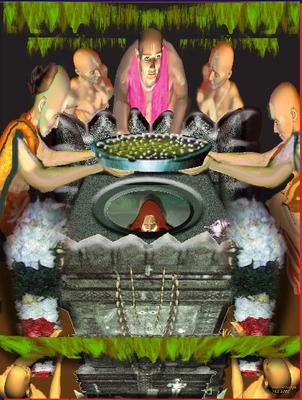
OM SRI RAGHAVENDRAYA NAMAHA!
****************************
The above picture dipicts the event of Raghavendra Swami being placed
into samdhi whilst still alive, along with his beloved Shaligrams
Message: 2
Date: Thu, 17 Feb 2005 13:14:40 +0530
From: "Sateesh" <sateeshg@hotmail.com>
Subject: FW: [IGR]: Shaligrama Mahima In English Part 1
Sent: Tuesday, February 08, 2005 11:22 AM
To: brindavan@gururaghavendra.com; articles@gururaghavendra.com; info@gururaghavendra1.org
Subject: [IGR]: Shaligrama Mahima In English Part 1
As many devotees requested for english version of shaligrama mahima
now we are publishing in english. Soon we also publish in kannada language.
Send your comments to webmaster@gururaghavendra.com (this was sent
via VMS Vishva Madhwa Sangha yahoo groups)
WONDERS OF THE SALIGRAVA PART 1
It is believed that GOD appeared the
very moment stone was formed. 'SARGARA', 'PASHANAM'. 'SILA', 'PRASRAM'
and 'SARGARA' all refer to rocks, pebbles and black mountainous stones.
The above words can be found in all the four VEDAS (holy scriptures ).
Of these, the word "GRAVA' appears in the RIG VEDA. Refer to the
mantra, "GRAVANA THUNTHO ABISHTOOTHAR". When combined with the word 'GRAVA',
it becomes 'SALISA ASOWGRAVASA' abbreviated as 'SALIGRAVA' or 'SALAGRAVAM'.
Various minerals, rocks, an alloy of metals, iron, glass and asbestos collect
in the crevices of rocks, mountainous streams, rivers and sand-beds where
they settle and stagnate. This process, in due course causes the formation
of Saligrava stones. As they are self-formed, these are known as 'suyambu
statues'. The factors that determine the quality of a saligrava are its
colour, brightness, well-rounded shape, impressions and wheels. These types
of stones can be found in very, very ancient river-beds too. These stones
possess inherent energies that render them worthy of worship as they have
been lying underneath the waters for a very long time, perhaps for thousands
of years and have been duly energized spiritually through constant prayer
and worship, upon their discovery, by our elders for generations. It is
a firm belief that the worship of the Saligrava alone can assure one of
salvation (moksha) and happiness (boham). I have written about the
glory of these stones, to the best of my knowledge for the benefit of the
believer, based on information extracted from the 'Garuda', 'Agni'
and the 'Vishnu' Puranas (legends) and on my own experience and research.
Saligravas can be categorized into several types. Some say there are 24,
48 and even 64 types. Let me refresh what I've learnt in the 46th chapter
of the 'Agni' Purana. Circles, lines and dots are generally found in these
stones. A Saligrava with a hollowed interior has circles in this region.
Such circles are absent in unacclimatised stones. It is said that the formation
of the circles are due to the burrowing of these stones by a particular
worm called the 'vajrathamshtra keedam' This, infact is true.
(to be continued)
TRANSLATED BY: SUSILA
http://www.salagram.net/sstp-shaligrama-mahima.html
More Articles like this HERE:
http://www.salagram.net/sstp-ARTICLES.html


 Sri Hari Bhakti Vilas excerpt on Salagrams
Sri Hari Bhakti Vilas excerpt on Salagrams
Hari-Bhakti-Vilasa is based on notes collected by Gopal
Bhatta Goswami and is known as a vaishnava smriti. If one examines its
content, one will see that its content closely conforms to the instructions
given Sanatana Goswami by Sri Caitanya.
Srila A.C. Bhaktivedanta Swami summarizes its contents
as follows:
This vaishnava-smriti-grantha was finished in twenty chapters,
known as vilasas. In the first vilasa there is a description of how a relationship
is established between the spiritual master and the disciple, and mantras
are explained.
In the second vilasa, the process of initiation is described.
In the third vilasa, the methods of Vaishanva behavior
are given, with emphasis on cleanliness, constant remembrance of the Supreme
Personality fo Godheaed, and the chanting of the mantras given by the initiating
spiritual master.
In the fourth vilasa are descriptions of samskara, the
reformatory method; tilaka, the application of twelve tilakas on twelve
places of the body; mudra, marks on the body; mala, chanting with beads;
and guru-puja, worship of the spirtiual master.
In the fifth vilasa, one is instructed on how to make
a place to sit for meditation, and there are descriptions of breathing
exercises, meditation and worship of the salagram-sila representation of
Lord Vishnu. (see below)
In the sixth vilasa, the required practices for inviting
the transcendental form of the Lord and bathing Him are given.
In the seventh vilasa, one is instructed on how to collect
flowers used for the worship of Lord Vishnu.
In the eight vilasa, there is a description of the Deity
and instructions on how to set up incense, light lamps, make offerings,
dance, play music, beat drums, garland the Deity, offer prayers and obeisances
and counteract offenses.
In the ninth vilasa, there are descriptions of the devotees
of the Lord (Vaishnavasa or saintly persons).
In the eleventh vilasa, there are elaborate descriptions
of Deity worship and the glories of the holy name of the Lord. One is instructed
on how to chant the holy name of the Deity, and there are discussions about
offenses committed while chanting the holy name, along with methods for
getting relief from such offenses. There are also descriptions of the glories
of devotional service and the surrendering process.
In the twelfth vilasa, Ekadashi is described.
In the thirteenth vilasa, fasting is discussed, as well
as observance of the Maha-dvadashi ceremony.
In the fourteenth vilasa, different duties for different
months are outline.
In the fifteenth vilasa, there are instructions on how
to observe Ekadashi fasting without even drinking water. There are also
descriptions of branding the body with the symbols of Vishnu, and discussions
of Caturmasya observations during the rainy season, and discussions of
Janmasthami, Parsviakadashi, Shravana-dvadashi, Rama-navami, and Vijayi-dashami.
The sixteenth vilasa discusses duties to be observed
in the month of Karttika (October-November), or the Damodara month, or
Urja, when lamps are offered in the Deity room or above the temple. There
are also descriptions of the Govardhana-puja and Ratha-yatra.
The seventeenth vilasa discusses preparations for Deity
worship, maha-mantra chanting and the process of japa.
In the eighteenth vilasa the different forms of Sri Vishnu
are described.
The nineteenth vilasa discusses the establishment of
the Deity and the rituals observed in bathing the Deity before installation.
The twentieth vilasa discusses the construction of temples,
referring to those constructed by the great devotees.
Sri Santana Goswami's commentary on Hari-Bhakti-Vilasa
is called the Dig-Darhsini-Tika. Sri A.C. Bhaktivedanta Swami Prabhupada
writes of Hari-Bhakti-Vilasa: "Another famous book by Sanatana Goswami
is the Hari-bhakti-vilasa, which states the rules and regulations for all
divisions of Vaishnavas, namely Vaishnava householders, Vaishnava brahmacaris,
Vaishnava vanaprasthas and Vaishnava sannyasis." Srila A.C. Bhaktivedanta
Swami Prabhupada notes, "This book was especially written, however, for
Vaishnava householders."
SALAGRAMA SILA TOYAM YAH PIVET VINDUNA SAMAM
MATUH STANYAM PUNAR NAIVA SAPIVET BHAKTI BHANG NARAH
(HARI BHAKTI VILASA 9/22 from PADMA PURANA)
Any person, if he has even taken one drop of water
which has washed Salagram Sila, he will not have to suck a mother's breast
again in the future.
BHAKTYA BHUNAKTI NAIVEDYAM SALAGRAMA SILARPITAM
KOTIM MAKHASYA LABHATE PHALAM SATA SAHASRASAH
(HARI BHAKTI VILASA 9/395 from SKANDA PURANA)
One who eats food after offering it to Salagram
Sila, he achieves the results of performing one hundred times one thousand
times one million fire sacrifices
YE PIVANTI NARA NITYAM SALAGRAMA SILA JALAM
PANCA GAVYA SAHASRAIS TU SEVITAIH KIM PRAYOJANAM
(HARI BHAKTI VILASA 9/20 from PADMA PURANA)
Any person who has drank the water which has bathed
Salagram Sila, what is the need for them to drink thousand and thousands
of times pancagavya? (Pancagavya is made from five auspicious products
of a cow offered to the Lord.)
NAIVEDYAM PURATO NYASTAM DRSTVAIVA SVIKRTAM MAYA
BHAKTASYA RASANAGRENA RASAM ASNAMI PADMAJA
(HARI BHAKTI VILASA 10/360 from BRAHMA PURANA spoken by
the Supreme Lord)
Oh Brahma, if someone makes an offering of food
grains in front of Salagram Sila (who is non-different from Me),
I just by looking at it eat it, but I taste the food when My devotees
touch it with their tongues (eat it).
GANGA GODAVARI REVA NADYO MUKTI PRADAS TU YAH
NIVASANTI SA TIRTHAS TAH SALAGRAMA SILA JALE
KOTI TIRTHA SAHASRAIS TU SEVITAIH KIM PRAYOJANAM
TIRTHAM YADI BHAVET PUNYAM SALAGRAMA SILODBHAVAM
(HARI BHAKTI VILASA 3/293,294 from PADMA PURANA)
The water which washed Salagram Sila includes the
water from the Ganga, Godavari, Reva and other liberating rivers. If this
bath water from the Salagram Sila is available, then there is no need for
thousands of other places of pilgrimage.
GANGA PRAYAGA GAYA NAIMISA PUSKARANI
PUNYANI YANI KURU JANGALA YA MUNANI
KALENA TIRTHA SALILANI PUNANTI PAPAM
PADODAKAM BHAGAVATAH PRAPUNATI SADYAH
(HARI BHAKTI VILASA 3/301 from NRSINGHA PURANA)
Ganga, Prayaga, Gaya, Naimisa, Puskara, Kuruksetra,
together with other places of pilgrimage, remove the sins of a person after
long connection with them. But water which has washed the lotus feet of
the Supreme Personality of Godhead at once purifies a person.
(HARI BHAKTI VILASA 5/257,258,259 from SRIMAD BHAGAVATAM
11.27.12-14)
Stone, wood, iron or metal, mud, picture, sand,
mind and jewels are the eight ingredients that Deities can be made from
in this world. Therefore, there are two kinds of Deities, movable and immovable,
into which the Supreme Lord is called. Oh Uddhava, with both the movable
and immovable forms, the Lord may be invited or sent away, but in the form
of Salagram Sila, this principle in not applicable He is eternally there.
Bathing of wooden or clay Deities is done with a wet cloth. Otherwise,
all the Deities are bathed with water.
GANDAKYAS CA IVA DESE CA SALAGRAMA STHALAM MAHAT
PASANAM TAD BHAVAM YAT TAT SALAGRAMAM ITI SMRTAM
(HARI BHAKTI VILASA 5/296 from GAUTAMIYA TANTRA)
Near the Gandaki River, there is a big place called
Salagram. The stones which appear in that place are called Salagram Sila.
SNIGDHA KRSNA PANDARA VA PITA NILA TATHAIVA CA
VAKRA RUKSA CA RAKTA CA MAHA STHULA TU LANCCHITA
KAPILA DARDURA BHAGNA BAHU CAKRAIKA CAKRIKA
BRHAN MUKHI BRHAC CAKRA LAGNA CAKRATHAVA PUNAH
BADDHA CAKRA ATHAVA KACID BHAGNA CAKRA TV ADHOMUKHI
(HARI BHAKTI VILAS 5/297,298 from SKANDA PURANA)
There are different kinds of Salagram Silas available
such as oily ones, black ones, yellow ones, blue ones, crooked, dry ones,
red ones, huge ones, without any marks, brown ones, in the shape of a frog,
broken, with one or many disk marks, with many faces, specific? grand disk
mark?, with a broken disc, facing down, complete disc, half disc, etc.
KHANDITAM SPHUTITAM BHAGNAM PARSVA BHINNAM VIBHEDITAM
SALAGRAMA SAMUDBHUTAM SAILAM DOSAVAHAM NA HI
(HARI BHAKTI VILASA 5/309 from BRAHMA PURANA spoken by
the Supreme Lord)
Even if the Salagram Sila is broken in half or broken
a little, or having a broken back, even in such a condition, Salagram Sila
is free from fault and can be worshiped.
KHANDITAM TRTITAM BHAGNAM SALAGRAME NA DOSABHAK
ISTA TU YASYA YA MURTIH SA TAM YATNENA PUJAYET
(HARI BHAKTI VILASA 5/310 from SKANDA PURANA spoken by
Lord Siva)
Broken, deformed or slightly broken Salagram Sila
can be worshipped. There is no fault in worshipping Salagram Sila in these
conditions. Whatever form one appreciates, he should worship Him very carefully.
KAMAIH KRODHAIH PRALOBHAIS CA VYAPTO YO'TRA NARADHAMAH
SO'PI YATI HARER LOKAM SALAGRAMA SILARCANAT
(HARI BHAKTI VILASA 5/370 from PADMA PURANA)
Those people who are the lowest of mankind and who
are controlled by lust, anger and greed can be elevated to the abode of
Lord Hari by worshiping Salagram Sila.
DIKSA VIDHANA MANTRAJNAS CAKRE YO BALIM AHARET
SA YATI VAISNAVAM DHAMAM SATYAM SATYAM MAYO DITAM
(HARI BHAKTI VILASA 5/374 from PADMA PURANA)
Anyone who has attained mantra diksa initiation
properly and is worshiping Salagram Sila, whatever he offers to Salagram
Sila, he achieves the abode of Lord Visnu. Of this, there is no doubt.
I personally say this.
SALAGRAMA SILA CAKRAM YO DADYAD DANAM UTTAMAM
BHU CAKRAM TENA DATTAM SYAT SASAILAM VANAKANANAM
(HARI BHAKTI VILASA 5/382 from PADMA PURANA)
Giving charity of Salagram Sila is the best of all
charities. Any person who has given this charity has achieved the result
of performing all auspicious activities and he has given charity of the
whole earthly planet, decorated with forest, jungles, and mountains.
DRSTVA PRANAMITA YENA SNAPITA PUJITA TATHA
YAJNA KOTI SAMAM PUNYAM GAVAM KOTI PHALAM BHAVET
(HARI BHAKTI VILASA 5/384 from SKANDA PURANA)
Lord Siva spoke to Skanda, his son, saying that
any person who has seen Salagram Sila, paid obeisances to Him, bathed and
worshipped Him, has achieved the results of performing ten million sacrifices
and giving ten million cows in charity.
PUJITO'HAM NA TAIR MARTYAIR NAMITO'HAM NA TAIR NARAH
NAKRTAM MARTYA LOKE YAIH SALAGRAM SILARCANAM
(HARI BHAKTI VILASA 5/396 from SKANDA PURANA)
(Lord Siva speaks to his son, Skanda) In this mortal
world, if anyone does not worship Salagram Sila, I do not at all accept
any of their worship and obeisances.
YO DADATI PHALAM VISNOH SALAGRAMA SAMUDBHAVAM
VIPRAYA VISNU BHAKTAYA TENA ISTAM BAHUBHIR MAKHAIH
(HARI BHAKTI VILASA 5/407 from SKANDA PURANA)
Any person who has donated a Salagram Sila to the
devotee of Lord Visnu (Vaisnava) or to a qualified pure brahmana, he has
achieved the results of performing unlimited sacrifices and austerities.
SA DHANYAH PURUSO LOKE SAPHALAM TASYA JIVITAM
SALAGRAMA SILA SUDDHA GRHE YASYA CA PUJITA
(HARI BHAKTI VILASA 5/409 from SKANDA PURANA)
In any house, if a person worships Salagram Sila
properly, those persons are glorified and their existence is successful
in this world.
SALAGRAMA SILARUPI YATRA TISTHATI KESAVAH
NAVADHANTE'SURAS TATRA BHUTA VETALAK ADAYAH
SALAGRAM SILA YATRA TAT TIRTHAM TAT TAPOVANAM
YATAH SANNIHITAS TATRA BHAGAVAN MADHUSUDANAH
(HARI BHAKTI VILASA 5/427,428 from BRHAN NARADIYA PURANA)
In any place, if Lord Keshava is situated there
in the form of Salagram Sila, there, neither demons, nor ghosts, nor devils,
can create any obstacles to that person or place. Any place where Salagram
Sila is situated can be turned into a place of pilgrimage and a place for
performing austerities because the Supreme Personality of Godhead, Madhusudana
(killer of the Madhu demon, personally resides there.)
SALAGRAMA SILAYAM YO MULYAM UDGHATAYET NARAH
VIKRETA CA ANUMANTA CA YAH PARIKSAM UDIRAYET
SARVE TE NARAKAM YANTI YAVAD AHUTA SAMPLAVAM
ATAH SAMVARJAYED VIPRA CAKRASYA KRAYA VIKRAYAM
(HARI BHAKTI VILASA 5/436,437 from SKANDA PURANA Lord
Siva to Skanda)
Oh brahmana, under no circumstances should anyone
ever buy or sell Salagram Sila. One should not even suggest a price to
be paid for Salagram Sila. No one should find faults in Him or explain
some mistakes in Him. All of these persons must go to the hellish planets
and live there until the complete annihilation.
SALAGRAMA SILAYANTU PRATISTHA NAIVA VIDYATE
MAHA PUJANTU KRTVADAU PUJAYET TAM TATO BUDHAH
(HARI BHAKTI VILASA, 5/438 from SKANDA PURANA)
There is no installation process for Salagram Sila.
The learned and purified souls have recommended a grand worship of Him
and then regular worship thereafter.
SALAGRAMA SILAYANTU SAKSAT SRI KRSNA SEVANAM
NITYAM SANNIHITAS TATRA VASUDEVO JAGAD GURUH
(HARI BHAKTI VILASA 5/444 from PADMA PURANA)
The worship of Salagram Sila is the worship of Lord
Hari directly. Jagat Guru, the spiritual master of the universe, Lord Vasudeva,
eternally resides within Salagram Sila.
STRIYO VA YADI VA SUDRA BRAHMANAH KSATRIYADAYAH
PUJAYITVA SILA CAKRA LABHANTE SASVATAM PADAM
(HARI BHAKTI VILASA 5/452 from SKANDA PURANA conversation
between Lord Brahma and Narada Muni)
Worship of Salagram Sila can be done by women, sudras
(low caste), brahmanas (twice born), ksatriyas (administrators), etc. and
they can all achieve the eternal abode of Lord Krsna perfectly.
http://www.salagram.net/HariBhaktiVilasHBV.html


Annapurna, the Sacred Land
Viewed through the eyes of a Buddhist or Hindu, mountains are mystical
realms of Gods, heavens, spirits and spiritual masters. Revered as "Sacred
Mountains visions of transcendent splendor and spiritual liberation. Invoking
such visions, the Puranas, ancient works of Hindu mythology, could not
describe to you the glories of Himachal; that Himachal where Siva dwells
and where the Ganges falls like the tendril of a lotus from the foot of
Vishnu.
The Kali Gandaki river falls between the giant snow-peaks Dhaulagiri
(8167m) and Annapurna (8091m), on its tumultuous descent to the Ganges.
The enormous canyon it has carved is the deepest in the world. Its journey
starts on the high plateau of Mustang – a surreal landscape of towering
cliffs and rock spires, of pastel hues and breathtaking beauty. Tibetan
Buddhist monasteries set high above its banks, look down serenely on the
river’s passing the Sacred Grove of Muktinath: a place of power, sacred
to both Hindus and Buddhists. It is said: one who comes into contact with
their sacred streams will be liberated from the cycle of deaths, even if
he be a sinner. There are no other mountains like Himachal, for there are
found Mount Kailas and Lake Manasarovar. As the dew is dried up by the
morning sun, so are the sins of mankind by the sight of Himachal. The epic
Mahabharata speaks of its sanctity (Bhishma-parva)
Saligram stones are found only in the river Gandaki, celebrated since
antiquity as Narayani, Saligrami, Hiranvati and Hiranyavati. The
puranas also describe it as a sacred stream in which all the gods and titans
abide . By merely looking at it, one would eliminate all his mental defilement’s,
by touching it his bodily sins are burnt up, and by sipping its water the
verbal demerits are thrown out. One who comes into contact with this sacred
stream will be liberated from the cycle of birth and deaths, even if he
be a sinner. There is a lake at the source of the Kali-Gandaki , called
Damodar-kunda at Nepal . The lower Gandaki is well known as Mukti-natha-kshetra,
also called Saligrama-kshetra. The sacred stones are largely found on the
banks of Kali-gandaki near Tukche, between the two mountains Dhavala-giri
and Annapurana. Damodara-Kunda is a Saivite place of pilgrimage : These
spots where saligrama-stones are found located within the Nepal territory.
Actually there are four spots in the river within Nepal jurisdiction, where
the sacred stones are picked up.
For those who believe it is said if he worships a saligrama-stone with
prostration before it, he will surely get emancipated from the cycle of
phenomenal existence. Worshipped by regular bathing saligram stones in
curds, ghee, milk or water will give untold merit and will bestow all the
benefits. The person who offers a daily service for the saligrama stone
will be freed from the fear of death, and he will cross over the stream
of births and deaths believed to have fallen from heaven, associated with
the thunder-bolt. Hence they would be regarded by the Hindus as more especially
sacred to Vishnu, who was originally a divinity representing the various
forms of light, one of his manifestations being the lightning. The fossils
were all believed to be antidotes for poison and also to make the wearer
victorious over his enemies. Hence they were sometimes set in the pommels
of swords. That these objects were equally potent in peace, is shown by
the fact that Danish peasant women placed them in their milk pails to ward
off the effects of any spell that might have been cast over the cow's milk
by a malevolent witch........
an article I found on ebay, of all places, where someone is selling
Salagrams........







 Some correspondence:
Some correspondence:
Funny story ...from Ekendra prabhu to JTCd
The other day my wife Seva Kunja dasi was having her non-devotee dad
over. Before I left for school I was about to do Bala Gopala's puja and
she asked,
"How could I explain who Gopala is to a non-devotee?"
Very confidently I replied (right in front of Gopala),
" I wouldn't bother trying to explain. Best to just avoid the subject
altogether and just give your dad some prasadam or put some of Gopala's
bathing water in his drink."
"Well, what if my dad asks about Gopala?", she asked.
"Even then I would try to avoid the subject really. Mabye just say 'That's
not really public information' or something to that effect and change the
subject."
So Gopala is hearing all of this.
Later on I was in school in the computer lab trying to pass the time
there by browsing your site. I was looking at all of the beautiful Saligrams
there and really tasting nectar to the point where I was a bit oblivious
to my surroundings. Then my professor came looking over my shoulder and
asked "What's that you are looking at?"
I was a little jarred out of my absorption in the beauty of your site
so I didn't quite have time to think of a clever reply.
At the time I was on the page listing the New Zealand sevaks and I asked,
"Are you sure you want to know?"
"Yes. That looks interesting", was her reply.
So I clicked on Gopala's link and gave her a proper darsana.
She seemed at bit taken back by His beauty as well and asked for some
explanation.
"What is that?"
"'Who is that?' would be more accurate", I responded "That's Sri Bala
Gopala."
"Where is He from? Is this from India or Indionesia?", she asked as
she scanned the text beneath His photo.
"He is from the river Gandaki but now He lives in our lounge room."
She was particularly noticing the words 'Bala Gopala' so I gave her
some explanation ...
"'Bala' means 'little' and 'Gopala' means 'friend of the cows' - so
'Little Friend of the Cows' is what that means. Its actually another name
for Krishna who takes the form of this blackish stone to accept our devotion."
She seemed quite curious so I got to preach to her a little bit.
She left the short conversation a little perplexed but appreciative
it seemed.
Funny how Gopala arranged that for me. I guess I should be thinking
'Who am I to decide who can and can't know who Gopala is? Really its my
duty to try to explain who Gopala is to everyone. If I were a real devotee
this would be done out of affection for Him and not even just dutifully.'
Please feel free to use this story in any way you want.
Your servant,
Ekendra das
http://www.gopala.org/

 Puja Paraphernalia
on-line
Puja Paraphernalia
on-line
 Agarbhatti
- Finest world class incense on-line
Agarbhatti
- Finest world class incense on-line
 All
Crowns, Alankaras, Mukut, Jari, Sringar etc - for the Deity worship, made
by devotees:
All
Crowns, Alankaras, Mukut, Jari, Sringar etc - for the Deity worship, made
by devotees:
 Nepali
style puja paraphernalia - chamaras - conches - Deities - Salagram rings
and pendents
Nepali
style puja paraphernalia - chamaras - conches - Deities - Salagram rings
and pendents
 Puja
paraphernalia on-line - Yantras - Achaman cups - patras - lamps - yajna
kundas etc
Puja
paraphernalia on-line - Yantras - Achaman cups - patras - lamps - yajna
kundas etc

 Advertisements
for Salagram friendly sites:
Advertisements
for Salagram friendly sites:
Iskcon's Official Deity worship site:
http://www.deityworship.com
Archana articles and links:
http://www.hknet.org.nz/index-archana.htm
Some wonderful insights into Amara prabhu's site and pujas
in Germany
http://amaraji.km1425.keymachine.de/puja_english.html
Sriman Mathura dasa @ Mystic Mantra
http://www.mysticmantra.com/
Rudraksha-ratna - Srimati Neeta Sharma Mataji
http://www.rudraksha-ratna.com/
http://www.rudraksha-ratna.com/shaligrams.htm
Nepa Rudraksha - Sriman Mukunda Khatiwadi
http://www.nepalirudraksha.com/
Saligram Organization
http://www.saligram.org/
Incense and Oils for puja - SRI NILACHAL EXPORTS
http://www.salagram.net/sstp-puja-para2.html
mailto:srinilachal@hotmail.com
Organize, print and share your digital photos - Click
here to get the software for FREE
http://www.kodak.com/go/easysharerd

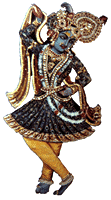 Some enlivening
URLs to visit:
Some enlivening
URLs to visit:
Picture galleries from India - totally wonderful
http://www.touruniversal.com/album/india.htm
Transcendental Picture Gallery:
http://www.harekrsna.com/gallery/gallery.htm
Various prayers for reading or reciting:
http://www.stephen-knapp.com/a_little_book_of_prayers_mantras_gayatris.htm
Bhaktivedanta Museum & Library - New York
http://www.radhagovinda.net/museum/home.htm
All different things in relation to seva
pujan
Our ARTICLES page with links to many aspects
of seva pujan

 News
Item: Now is a VERY good time to utilize this facility
News
Item: Now is a VERY good time to utilize this facility
Pilgrimage to the "Top of
the World"
 Visit Muktinath
or Damodar Kund in Northern Nepal the home of the Shaligram Sila
Visit Muktinath
or Damodar Kund in Northern Nepal the home of the Shaligram Sila
Fly up the Kali-gandaki gorge, the deepest
natural gorge on the planet amid the towering Annapurna range of Himalayas.
An experience of a life-time, with stunning
views that will remain with you treasured for the rest of your life.
Take a quick look here to whet your
appetite....
There are two pilgrimage time periods when
this region is accessible, as the rest of the year it is snow-bound.
Pre-monsoon pilgrimage:
April - May - June
Pre-winter pilgrimage:
End of September - October - November
Kathmandu - Pokhara (By bus or plane - bus
takes six - eight hours, plane takes less than an hour)
Pokhara - Muktinath (by Helicopter) where devotees
get one hour to worship Muktinath and fly back to Pokhara then back to
Kathmandu.
Cost US $400.00 + $40.00 (if ktm-Pok by plane)
For Kathmandu - Pokhara (By bus or plane) Pokhara
- Damodar kunda (by Helicopter) and fly back to Pokhara then back to Kathmandu.
Cost US $850.00 + $40.00 (if ktm-Pok by plane)
Damodar kunda Trekking Itinerary
 Day 01: Arrive at Kathmandu
and transfer to Hotel
Day 01: Arrive at Kathmandu
and transfer to Hotel
 Day 02: Half day sight seeing
tour.
Day 02: Half day sight seeing
tour.
 Day 03: Ply to Pokhara
Day 03: Ply to Pokhara
 Day 04 :Fly Pokhara – Jomsom
and trek to Kagbeni
Day 04 :Fly Pokhara – Jomsom
and trek to Kagbeni
 Day 05: Kagbeni - Tashukang
O/N Camp
Day 05: Kagbeni - Tashukang
O/N Camp
 Day 04: Tashukang - Tetang
O/N Camp
Day 04: Tashukang - Tetang
O/N Camp
 Day 05: Tetang - Tange O/N
Camp
Day 05: Tetang - Tange O/N
Camp
 Day 06: Tange - Surkhang
O/N Camp
Day 06: Tange - Surkhang
O/N Camp
 Day 07: Surkhang – Luri
O/N Camp
Day 07: Surkhang – Luri
O/N Camp
 Day 08: Lur i- Bas Khola
O/N Camp
Day 08: Lur i- Bas Khola
O/N Camp
 Day 09: Bas Khola – Damodar
Kundai O/N Camp
Day 09: Bas Khola – Damodar
Kundai O/N Camp
 Day 10: Damodar Kunda- Luri
O/N Camp
Day 10: Damodar Kunda- Luri
O/N Camp
 Day 11: Luri - Ten O/N Camp
Day 11: Luri - Ten O/N Camp
 Day 12: Ten – Tetang O/N
Camp
Day 12: Ten – Tetang O/N
Camp
 Day 13: Tetang- Muktinath
Day 13: Tetang- Muktinath
 Day 14: Muktinath-Jomsom
Day 14: Muktinath-Jomsom
 Day 15: Jomsom- Pokhara
Day 15: Jomsom- Pokhara
 Day 16: Pokhara- Kathamndu
and transfer to hotel
Day 16: Pokhara- Kathamndu
and transfer to hotel
 Day 17: Rest and explore
your self.
Day 17: Rest and explore
your self.
 Day 18: Fly back to home.
Day 18: Fly back to home.
Details:
· Special Permit
for 10 days US$ 700.00 Per Person & above 10 days every day 70.00 US$
more extra.
· For Liaison
officer expenses have to pay by clients
· Client (s)
should have fill up all form for permit with in 15 days before, departure
for trekking
Cost - US $ 2600.00 per person for group of 5 people (Special
permit fee included)
Cost Includes:
a) All domestic air and land fares within Nepal.
b) All three course meals in trekking days (not in hotels in Katmandu)
c) All staff and trekking leader wages included.
d) 4 nights at Kathmandu and 1 night in Pokhara on Bed and Breakfast.
e) Departure and arrival transportation.
Cost does not include.
a) Visa fee - which will be purchased at your home country.
b) Special permit fee of Upper Mustang (US$700. - as of August 2003
we are now getting this Permit @ US$350. each)
c) Private and Personal Expenses.
d) Tips and donations that you may feel obliged to give along the way......
For those in doubt of ridiculous price of Special trekking permit, sadly
these are the prices for such a remote area as Upper-Mustang. The following
URLs are Nepali Government sites supporting and confirming the US$ 700
cost.http://www.manang.com/Trekking%20Permit.htm
and http://www.project-himalaya.com/info-visa.html
and http://www.buddhatreks.com/nepal/trekking/trekking-permit.htmsorry
!!!
(presently we are getting these permits for US $350 each 8th Aug
2003 - get back to us NOW.)
For Enquiries/Inquiries Bookings send E-mail
To get some idea of the views etc please visit HERE: Visit
Shaligram Tirtha

Have a Happy 2005
...may it be, healthy and prosperous
in every possible way

Sri swayam-vyakta
saligram silas ki jai
 Newsletters
On-line:
Newsletters
On-line:
 #006 - Kartik
2004
#006 - Kartik
2004
 #005 - April
2004
#005 - April
2004
 #004 - Dec
31st 2003 - 01st Jan 2004
#004 - Dec
31st 2003 - 01st Jan 2004
 #003 - Sept
2003
#003 - Sept
2003
 #002 - July
2003
#002 - July
2003
 #001 - April
2003
#001 - April
2003


Seeing is believing...

Cheapest and best web-hosting - click on the banner above
Starting at 1Gb or 2 Gb space for one or two years @ just
US$7.50 per month

A Grateful Word to our Supporters

 ...Outro'
...Outro'
Personally we find that so many devotees
are inspiring us in so many different ways, by the grace of the Lord. Especially
I'd like to thank HDG Srila A.C. Bhaktivedanta Swami Prabhupad for saving
my very life, and to HH Jayapataka Swami and HH Indradyumna Swami for all
the support and encouragement in seva pujan. There are literally hundreds
who have helped in this humble service of ours here, Paramseva dasa was
the catalyst for the web-site, Hrsikeshananda prabhu has kindly sponsored
the site and maintains it financially, so without his help it wouldn't
be, and similarly for the mirror site Tirtharaj prabhu allowed us space
and hosted us for free for some time with www.hknet.org.nz to both these
devotees we are so much indebted. Now we are kindly sponsored by Bhakta
Gary Kearns and Yagnesh Rajani on www.hknet.org.nz
on a huge new host - plenty of bandwidth. There are so many others who
have and are helping so much with articles, gifting Silas, books, and paraphernalia,
and support; special thanks to Gaura Keshava prabhu ACBSP, Ramadasa prabhu
ACBSP, Kurma prabhu ACBSP, Hari Sauri prabhu ACBSP, Sukadev prabhu ACBSP,
Bhaktisiddhanta swami JPS, Ameyatma prabhu PVS, Aisvarya prabhu HDG, Jvala
Nrsimha prabhu IDS, Matsya Avatara prabhu BTS, Mathura prabhu, Kailash
mataji, Hamsa Avatara prabhu, Jagjeevan prabhu and Sudevi mataji MVG, Vikram
and Aasha Murthy, and mother Neeta Sharma and Mukunda Khatiwada, Krishna
Akilesha prabhu, and my eldest daugther Kirtida Sundari (for doing so much
typing of articles) to name but a few. Sarv-lok vaishnavebhyo namo namah
so as not to miss anyone, as we so much appreciate all of you who are receiving
this newsletter, otherwise we wouldn't do all this, thank you so much for
just being part of it.
Indeed, many thanks to all the readers
who have one way or another subscribed to Sri Shaligram Tirtha Pradarshini
newsletter. Your interest and support makes this service possible. Those
wishing to contribute in any way to this 'Net-work, send articles, and
or information please do so by contacting me here ... mailto:salagram@xtra.co.nz
We are very grateful to our sponsors'
donations that help maintain this and similar devotional service, especially
on a regular basis, so again and again thank you. ...Couldn't do it without
you.
If anyone would like to send donations
to help maintain this and similar work,
especially on a regular basis please
contact me here also ...

Every little is VERY much appreciated,
and is what allows the service to continue regularly. Thanx
Donations can be made on-line at http://www.hknet.org.nz/
or through http://www.salagram.net/sstp-1.html
or go direct to our link below, all through our PayPal account.




After some feedback from our readers
we are trying to maintain that the newsletter go out Quarterly, (four times
a year - April, July, Sept, Dec). I hope that this is okay with everyone.
See you in a couple of weeks.
//
(@@)
_____ooO_(_)_Ooo_________________________________
|______|_____|_____|_____|_____|_____|_____|_____|
|___|____|_____|_____|_____|_____|_____|_____|____|
|_____|_____Please
pardon the intrusion_|____|______|
*Legalese -- This newsletter is NEVER
sent out unsolicited. If you are receiving this for an unknown reason,
maybe it's because of a friend giving us your address. We do not buy lists
or gather them via "Harvesting software(s)", nor will we ever give/sell
your address to anybody. If you would rather NOT receive mail from us,
please send us a message saying Unsubscribe, or Remove - and we will do
the needful immediately. We apologize for any inconvenience caused.
If somehow you are receiving this double
- ie., at home and in the office please let me know, and your preferential
option =>:-) JTCd
_/_/_/_/_/_/_/_/_/_/_/_/_/_/_/_/_/_/_/_/_/_/_/_/_/_/_/_/_/_/_/_/_/

***************************************************************
* compiled
by Purohit JAya Tirtha ChAran dAsan
*
* jtcd@xtra.co.nz
* salagram@xtra.co.nz
*
**************************************************************
* Sri
Shaligram Tirtha Pradarshini Homepage
* http://www.salagram.net/Sri-Shaligram-Tirtha.htm
* http://www.hknet.org.nz/Sri-Shaligram-Tirtha.htm
* http://www.salagram.net/index.html
* http://www.hknet.org.nz/index.html
**************************************************************













 ...
...
















 Some enlivening
URLs to visit:
Some enlivening
URLs to visit:
 Visit Muktinath
or Damodar Kund in Northern Nepal the home of the Shaligram Sila
Visit Muktinath
or Damodar Kund in Northern Nepal the home of the Shaligram Sila




